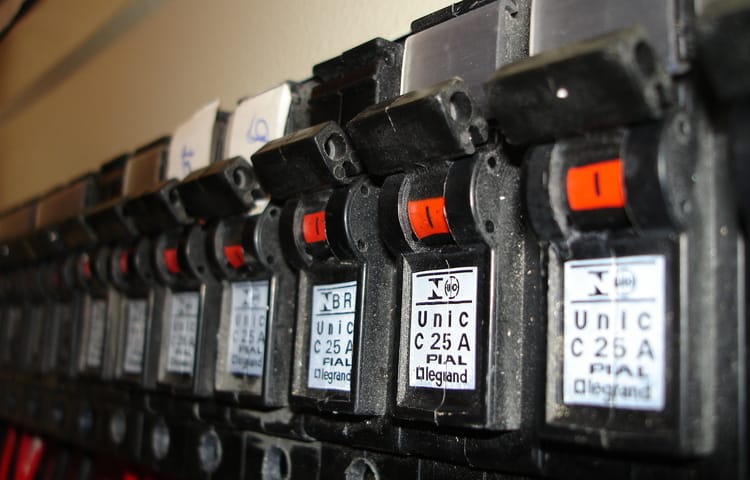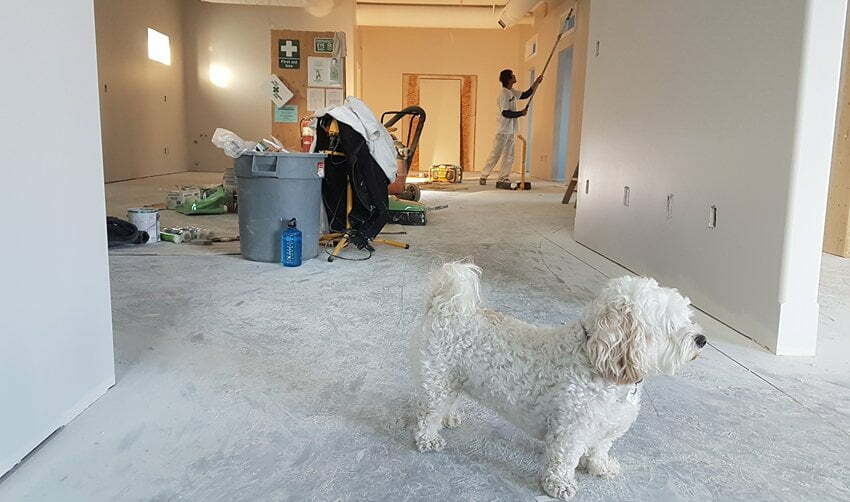Last Updated on January 1, 2024
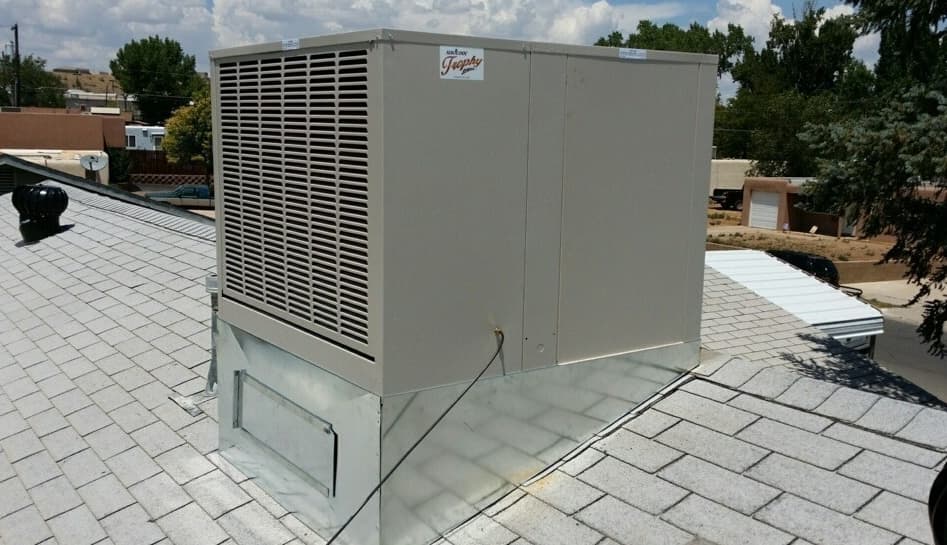
Are you using an evaporative cooler to cool your room or your home in a dry and hot environment? You will have to fill your cooler with water intermittently. How much it uses in a day or a night or in any time period? Well I researched to know the answer and decided to write a detailed article.
Depending upon the variation in size, an evaporative cooler uses from 4 liters to 25 liters of water per hour and an average of 10 % water annually per household. The amount of water that your swamp cooler uses in a specific time period depends on temperature, relative humidity, size, fan speed and drainage.
What is an Evaporative Water Cooler?
An evaporative cooler is an appliance that is used generally in hot and dry weather.
It allows the use of process of evaporation to cool the room and make it comfortable for you.
What is Evaporation
Evaporation is the process of phase change of water from liquid state to gaseous state without boiling it. This means that evaporation occurs at any temperature.
This conversion from liquid to gaseous state requires a lot of energy to be absorbed. This heat energy is consumed from the environment.
The loss of heat energy thereby results in cooling of the air surrounding the water. This cool air is used up by the evaporative water cooler to cool the room.
Construction of Evaporative Cooler
In evaporative cooler cooling is done without using the general vapor compression cycle used in air conditioners. This makes it much more efficient to use.
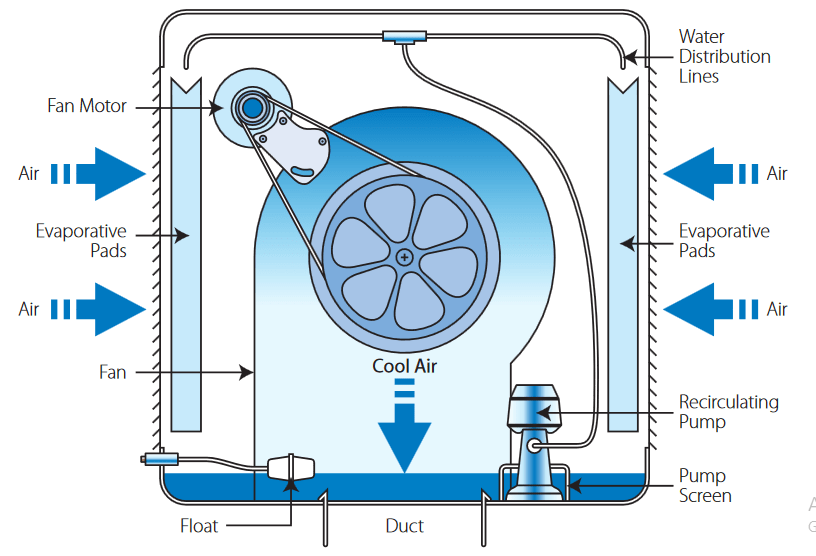
Evaporative cooler consist of a fan that is situated in a box. The box consists of holes in pattern that allow the movement of air through them when the fan is in operation.
The box is surrounded by cooling pads that have layers to increase their surface area. This is done due to the fact that surface area is directly proportional to rate of evaporation.
The water is contained in the water reservoir. The size of the water reservoir depends on the size of water cooler, and also on the intensity of the evaporative operation it has to perform and the volume of room or apartment it needs to operate in.
Water distributor is used to distribute water to the cooler pads so that the water falls well spread when the air is moving through the pads.
A water pump is required to continuously recycle water that has dropped from the water distributor through the cooling pads by the action of gravity.
The action is conducted at a suitable flow rate bringing water fallen down in the water reservoir back into the water distributor.
Operation of Evaporative Cooler
Hot air is sucked by the fan is blown through the evaporative pads that are installed at the surrounding of the box internally.
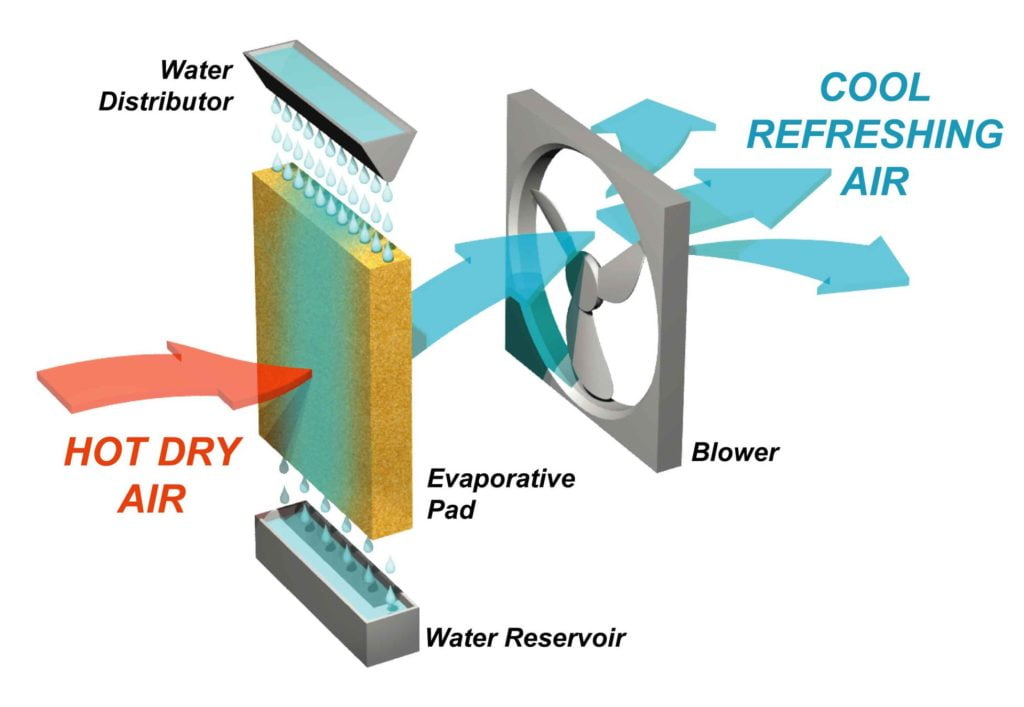
Circulation of water from water reservoir to water distributor then through cooler pads and back to water reservoir is conducted by the application of water pump.
The water pump operates at a suitable speed to maintain the desired flow rate to continuously operate this cycle until most of the water is evaporated after which the water reservoir is refilled.
The hot air passes through the water that is dripping through the cooler pads. The air comes in contact with water molecules that are moving on the extensive surface of cooler pads. This initiates the process of the evaporation.
The evaporated water cools the air by stealing heat energy from it during the process of the phase change as it has to convert to gas. The heat energy is called heat of vaporization.
This heat of vaporization is taken away from the air that has passed through the cooler pads resulting in cooling of air. It is then sucked by the fan of the cooler to provide cool air to the environment.
Factors that Affect Water Usage by an Evaporative Cooler
The amount of water used up for specific time during the operation of evaporative cooler depends on several factors. Some of the major factors are stated below:
Average Outdoor Temperature
The more the average temperature of the external environment the more will be the rate of evaporation.
Thereby the difference of temperature between outdoor and indoor temperature will directly depend on the outdoor temperatures during the operation of evaporative cooler.
The maximum temperature difference between indoor and outdoor temperature will result in maximum water usage during the operation of cooler due to the factor of temperature.
The graph provided below can help predict the variation of temperature during the day.
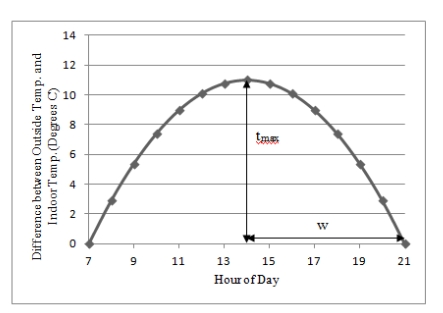
Relative Humidity of Air
Whenever a water surface is exposed to air that has a relative humidity less than 100% it will evaporate into the air.
The amount of humidity in the environment has an extensive effect on the operation of the cooler.
The more the humidity in the outdoors the less will be evaporation and thereby usage of water will be substantially reduced.
Fan Speed of Cooler
Higher fan speed means more air is sucked by it resulting in increased airflow rate through the cooler pads.
The higher rate of flow of air is proportional to evaporation as more water molecules will be able to escape from the surface of cooler pads.
This means conversion of more water in liquid state to gaseous state.
Size of Evaporative Cooler
The operation of cooler and the volume which has to be cooled by it is proportional to size of cooler.
Hence when faster operation of the evaporative cooler is required or the volume of the room that has to be cooled by cooler is large the size of the cooler is increased.
The increased size of the cooler will have extended surfaces for the air to flow (for increased evaporation) and larger reservoir to store greater amount of water.
Drainage to Prevent Mineral Deposits
The water that is used up by an evaporative cooler also depends on the quality of water that is being used and specifically salts and minerals present in it.
If the water is contained in the water reservoir for a long time it will cause mineral and salt deposits deteriorating the operation and quality of cooler.
The duration and frequency of change though depends highly on the area in which evaporative cooler operates.
Hence if you are in the area in which water has more salts, minerals and alkalinity then you will have to drain water more times.
Some evaporative cooler use drain valves for recirculation of water in order to replace it with fresh water. This prevents damage that can result from mineral deposits.
The frequency of drainage will depend on the quality of water.
How much Water an Evaporative Cooler Uses?
Considering the fact that many factors in maximum number of households are same for particular area we can calculate the average amount of water usage by the use of evaporative coolers.
However there will be significant contrast of water usage depending on the type of area.
Water Usage
It is evident form empirical studies that evaporative cooling system could use up to 10% of a household’s yearly water resources.
A compact unit may utilize something like 4 liters per hour while a central evaporative system could use as much as 25 liters for every hour.
Water that is consumed up is also majorly effected by model of evaporative cooler used even if the size is same. Further inexpensive and old model generally have more water usage.
The variation in water efficiency occurs from 0.45 MJ/L to 2MJ/L.
Refilling
An average water reservoir in an evaporative coolers is designed for 3 to 6 hours of operation before it has to be refilled. The larger coolers used outdoors have continuous water source with float valve for shutoff.
According to hessaire.com the average run times between refills are provided below:
| Water Reservoir Capacity | Average Runtime Before Refill |
| 7.5 gallons | 3.5 to 4 hours |
| 10.3 gallons | 3.5 to 4 hours |
| 14.6 gallons | 3 to 3.5 hours |
| 32.8 gallons | 2.5 to 3 hours |
Drainage
It is indicated by the Arizona Cooperative Extension, mineral buildup can abbreviate a cooler’s life by as much as 50%, so mineral and salt deposit is a major concern.
Mineral deposits can inferioirate a unit’s cooling limit, stopping up water lines and cushions. Intermittently depleting the tank can drastically lessen this issue.
For prevention of mineral deposits routine drainage could result in 50% increased water usage.
If smartly performed with intermittent operation it can be reduced to 10% (Arizona Cooperative Extension).
The issue can also be resolved by the use of water tank varying in size from 3 to 50 gallons. Not only will they allow larger backup of water but they will prevent the deterioration of the evaporative cooler if the water reservoir was contained inside the cooler.
Getting the Most Out of Your Evaporative Cooler
Use in a Dry Season/Weather
The evaporative cooler doesnot operate in humid climate because it is designed to operate on the process of evaporation.
As the relative humidity of the air increase the evaporation will actually decrease. Thereby evaporative cooler will definitely not work in a humid weather.
Proper Airflow through Appropriate Window Opening
Unlike traditional vapor compression air conditioning system in which the room has to be sealed to prevent loss of cooling, evaporative coolers require a definite flow rate.
This means that the windows have to be opened to some extent so that the dry air from outdoor is easily pulled by the evaporative cooler. This will also prevent the room to become humid and foggy.
Using a Dehumidifier
If the cooler has to be operated in somewhat humid environment a suitable humidifier will help prevent the humidity to build up in the room. This will ensure comfortable humidity levels.
Using Plants that Absorb Humidity
There are a number of plants that intake water by extracting humidity from air. They can make the humidity in the room to decrease. Some examples include cacti, yucca, aloe etc.
Positioning and Orientation
You are probably going to run the cooler for some large interval of time like a season or so.
It’s better to just experiment with the orientation and the position so as to make sure that cooling is carried out in the most effective way possible.
Keeping the Pads and Water System Clean
With the passage of time even if the care is taken dirt may become stuck in the pads. This will prevent the effective circulation of water through the cooling pads and significantly lower the performance of evaporative coolers.
Thereby routinely check the pads may be clean them sometimes. However when you know they are to be changed go for it.
You should also check that the cooling pads are wet properly. If after sufficient time they are not wet this means that the water system contains dust and has to be cleaned to restore performance.
Preventing Excess Ice and Using Cold Water If Possible
As counterintuitive as it sounds, using excessive amounts of ice may actually decrease the performance of cooler. This is due to decrease in evaporation that is crucial for evaporative cooler to work.
Using somewhat cold water may however be effective as the air coming in contact will lose temperature and the actual process required for cooling i.e. evaporation will also occur during the flow of air.
Running the Pump Prior to Fan
Before turning on the fan it might be a good idea to run the water pump. Actually this will allow the wetting of cooler pads. So that when the fan is turned on the airflow experiences maximum evaporation from the start.
Refresh the Water Supply
In case the water supply is automated i.e. the water reservoir automatically maintains level without replenishing it manually or even if the water generally stays for large intervals of time it can damage the cooler.
The long duration of water contained in the reservoir can result in mineral and salt buildup that may affect the performance of cooler to noticeable extent.
If the water in specific area has sufficient minerals and salts, and it stays for extended periods of time it would be almost impossible to remove it.
Choosing the Size Rightly i.e. a Bit Larger
Using a cooler that is a bit large for your room is a good idea. it will allow better operation, experience and comfortability.
Scratching and Scraping the Mineral and Salt Deposits
With the passage of time you will experience mineral buildup in your cooler. Even if you live in the area where water has comparatively less quantity of minerals it.
The best way to get rid of it is to scrape it off as soon as it builds. The place that has the maximum probability for it to be built is where the water is contained or passes from.
Clean the water distribution system, including the pump screen, pump impeller and water distribution tubes.
After scraping paint that surface, it will increase the time for the mineral buildup to reappear.
Lubricating the Water Pump
Any mechanically moving part requires routine lubrication to prevent friction. The pump operates continuously during the operation of cooler fan. Further its components continuously come in contact with water due to which oil is washed away.
Thereby after sufficient interval of time in order to keep the operation of cooler effective water pump impeller must be lubricated with motor oil.
Advantages of Using an Evaporative Cooler
Lower Initial and Installation Cost
Evaporative Cooler contrary to air conditioners operating on vapor compression cycle, have very low initial and installation cost. The initial cost of evaporative cooler is less than 50% of air conditioners.
Further the installation of evaporative cooling system is much less complicated and it is very cheap comparative to air conditioners.
Economical and Efficient Energy Consumption
One of the major advantage of using an evaporative cooler is extremely low electricity consumption.
The amount of energy consumed by an evaporative cooler is up to 80 % less as compared to traditional air conditioners. This is a major advantage of using an evaporative cooler.
Lower Operational and Maintenance Cost
Due to low electricity consumption as indicated earlier the operational cost is very low comparatively.
Further the maintenance required for evaporative cooler is extremely low compared to air conditioners. The reason is its simplistic design and operation.
The mechanically moving parts conduct simple operation unlike compressor (that has to build high pressure during compression), expansion devices and high pressure lines in air conditioners.
Environmentally Healthy
The evaporative coolers are free from chlorofluoro carbons that can pollute the environment and affect ozone layer.
It uses fresh atmospheric air to conduct the operation of evaporation that results in the delivery of cool air.
Fresh Air with Open Doors and Windows
Air conditioners require closed and isolated room to conduct their cooling operation. Evaporative cooler work effectively when operated in an area that has free cross of fresh air flow.
The windows and doors thereby are kept open to suitable extent during the operation of evaporative cooler. This allows delivery of fresh cooled air from outdoors to indoors.
My Recommendation?
In case you decide to buy a swamp cooler, I have narrowed the process for you. I have researched and recommend the following, mainly based upon functioning and durability but also pricing. Here, have a look:
Recommended Swamp Cooler: BREEZEWELL 2-in-1 Evaporative Air Cooler
This unit also comes with two ice packs that you may use to boost its cooling effect.


